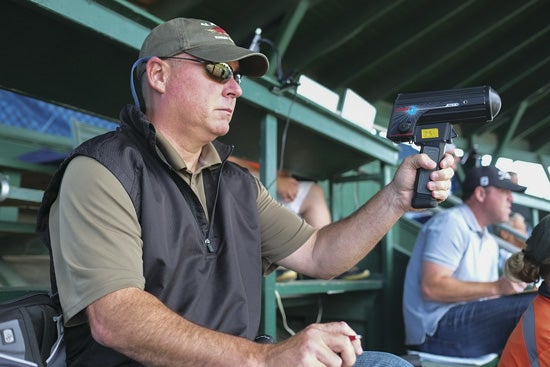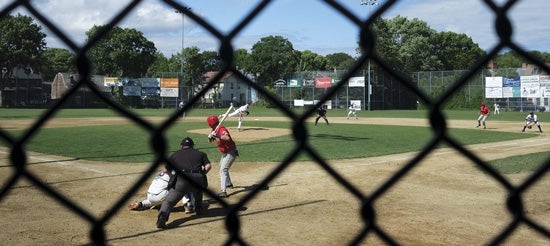Dream Maker

In a job that’s full of stats and speed guns, Steve Payne ’88 has to figure out something intangible: what lies inside the young players he tracks, and whether it’s enough to take them to the major leagues.
By Shane Donaldson ’99
The Miami Marlins made a bit of history when they drafted 17-year-old Josh Naylor with the No. 12 overall pick this June, during the 2015 Major League Baseball Draft. The selection made the power-hitting first baseman the highest pick ever among Canadian-born position players.
The driving force behind the Marlins’ first-round choice was Steve Payne ’88, a longtime scout for Miami. Payne—who played two seasons at West Hills Junior College in California and two seasons at Rhode Island College before finishing his degree at URI—is the team’s scouting supervisor for the Northeast and Canada.
“The draft worked out well,” Payne says, describing Naylor as “a young kid out of Mississauga, Ontario, who has a good bat with a lot of power.”
How does Payne feel so confident in his assessment of Naylor? “I have watched him for three years,” he says.
That’s three years of watching a teenager play ball, taking notes, keeping track, and betting that he’ll develop into a player who can make a significant impact at the major league level. That is Steve Payne’s life. He eats, sleeps and breathes the game he loves, constantly searching for the type of talent that can improve an entire organization.

Every summer Payne puts about 20,000 miles on the company car as he drives all over the Northeast and Canada to watch some of the best prospects in the game. He also regularly flies to Miami to check in at team headquarters.
There are nightly treks to the Cape to take in Cape Cod Baseball League action, and visits to Newport and Wakefield, R.I., to watch New England Collegiate Baseball League players. Those are the bigger names, but there are plenty more amateur leagues throughout the region and Canada, and for 20 years, Payne has been a regular visitor to them all.
“During baseball season, I’m constantly driving and flying,” says Payne, who lives in Barrington, R.I. “It’s a grind, but there’s a level of freedom that comes with the work. I like the travel, and obviously I enjoy the baseball aspect of it.”
Anyone involved in baseball in the Northeast understands scheduling can be one of the biggest challenges, thanks to the weather. Payne spends the early weeks of the scouting season in Florida and the Carolinas, watching prospects who have travelled to warmer environments.
“When you’re looking at high school kids, it can be a crapshoot,” he explains. “There are weather issues, the field may not be ready. When you see a kid, it could be a decent weather day, but they happen to have a tough day in the field. There are a lot of variables that you take into account.”
So he logs thousands of hours at the summer showcases, noting how each player stacks up against the top talent in the region.
“You get a good look at athletes against their peers and higher caliber players,” Payne says. “You do a lot of the initial work in the summer, and then as you track a player, you want to make sure you see consistencies as time goes on. Has a kid lost a step since the summer? Did he gain or lose weight? Does the velocity of his fastball stay the same?”
After years of evaluation, Payne was excited to see the Marlins draft Naylor—he says he always feels a sense of personal pride in the picks. But he makes sure to check his emotion at the door each year when draft time rolls around. He knows the organization won’t act on all his recommendations.
“Every year it varies. Some years, like this year, we draft a few of the guys I have been watching closely. Other years, it’s a bit lighter,” Payne says. “The key thing to remember is that we are always trying to get the best available player, regardless of where they are from. That’s our organizational goal. Get the best player available.”
Payne joined the Marlins in 2000 after previous stops scouting for the Colorado Rockies and Montreal Expos. Before that, he was coaching in the college ranks, including positions with the University of Tampa and Texas Tech.
“At Texas Tech, we recruited on a national level, so I was running in a lot of the same circles as scouts,” Payne remembers. “I was down on the Cape watching a game with the scouting director of the Colorado Rockies at the time. He had an opening, and basically I got the job on the spot.”
Payne has seen several picks reach the major leagues. While with Colorado, he scouted Jake Westbrook, whom the Rockies selected with the No. 21 pick of the 1996 draft. Westbrook played 13 seasons in the big leagues and was selected to the Major League Baseball All-Star Game in 2004.
Others include outfielder Juan Pierre—who played 14 big league seasons and ranks 18th all-time in stolen bases with 614—and Tom Koehler, a starter for the Miami Marlins for the last three seasons. Koehler was drafted out of Stony Brook in the 18th round of the 2008 draft and has worked his way into being a solid contributor for Miami.
Payne’s decisions can have life-changing consequences for the teenagers he watches. And despite all the tools of his trade—the speed guns, the number crunching—he says some of it comes down to instinct.
“The hard part is figuring out what a guy is made of on the inside,” Payne says. “Some guys have all the skills, but there is something missing mentally and the talent doesn’t translate. Other guys don’t have the natural ability, but when the lights are on and it’s time to perform, they thrive.”
He’s betting the newest name on his list of success stories will be Naylor, the 6-foot 1-inch, 225-pound teen who has been compared to big leaguers Prince Fielder and Pedro Alvarez.
Time will tell. But Payne’s work with Naylor is complete. Now, he’s hitting the road again, on the hunt amongst the next crop of talented dreamers.•
 Home
Home Browse
Browse Close
Close Events
Events Maps
Maps Email
Email Brightspace
Brightspace eCampus
eCampus


